A hundred years in the ranks: ageless "lemon"
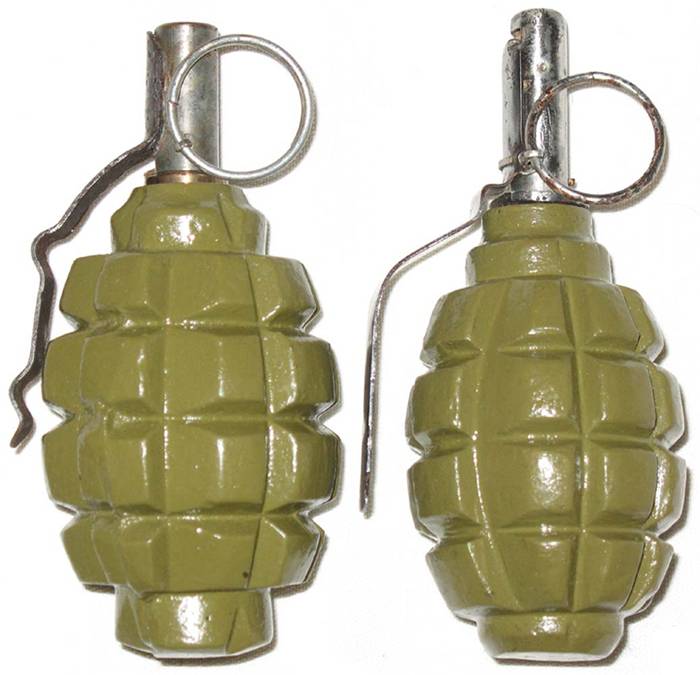
If we approach the issue formally, then the lifespan of this undoubtedly outstanding representative of the classic type of hand grenades will be not one hundred, but eighty-nine years. In 1928, the F-1 hand-held anti-personnel grenade (“lemon”) was adopted by the Red Army. But let's not rush things.
Немного stories
The prototype of a hand grenade has been known since the 9th century. These were earthen vessels of various shapes, filled with energy-saturated materials known at that time (lime, tar, “Greek fire”). It is clear that before the appearance of the first high explosives, it is not necessary to speak about the serious damaging effect of these ancient items. The first mention of explosive throwing hand shells belong to the X-XI century. The material for them was copper, bronze, iron, glass. Presumably, Arab merchants brought them from China or India.
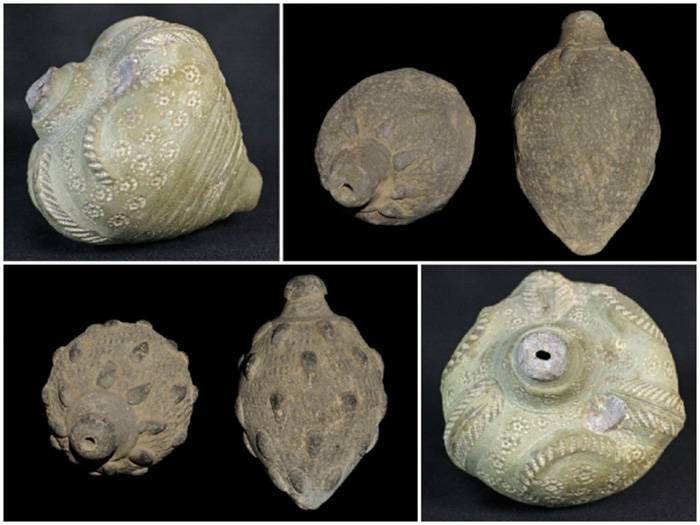
An example of such a device is the bann - developed in China in the first millennium AD. an incendiary grenade with a body made from a piece of hollow bamboo stem. Inside placed a charge of tar and black powder. On top of the bunny, they were plugged with a bundle of tow and used as a reinforced torch, sometimes a primitive wick containing nitrate was used. The Arabian "bortab" was a glass ball with a mixture of sulfur, nitrate and charcoal, equipped with a wick and a chain. fastened to the pole. In any case, the Nejim-Edlin-Chassan Alram manuscript describes it as a guide to the art of fighting on horseback and on various military vehicles. Such grenades provided not so much a striking, as a psychological and demoralizing effect on the advancing enemy.
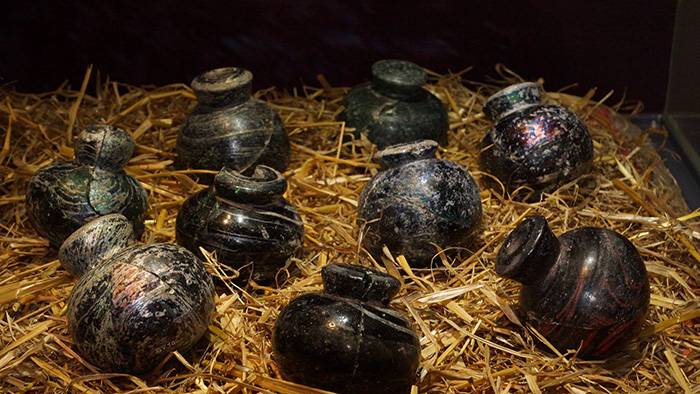
More than a hundred blown glass hand grenades almost intact, some of which have wicks. Archaeological Museum Mitilini, Lesbos.
The era of classic frag grenades began in 1405, when the German inventor Konrad Kaiser von Eichstadt proposed to use brittle cast iron as the body material, thanks to which the number of fragments generated by the explosion significantly increases. He also belongs to the idea of creating a cavity in the center of the powder charge, which significantly accelerated the combustion of the mixture and increased the likelihood of scattering pieces of the grenade body into small fragmentation striking elements. The weak blasting effect of black powder required an increase in the size of a grenade, while the physical abilities of a person limited this increase. A cast iron ball weighing from one to four kilograms could be thrown only by very trained fighters. Lighter shells, used by cavalrymen and boarding teams, had much lower efficiency.
Grenades were used mainly for assaults and defenses of fortresses, in boarding battles, and during the war of the Holy League (1511-1514), they proved to be very good. But there was a significant drawback - fuse. The smoldering fuse in the form of a wooden tube with powder pulp faded quite often when it hit the ground, did not give an accurate idea of the time before the explosion, detonating too early, before the throw, or too late, allowed the enemy to scatter or even return the grenade back. In the sixteenth century the term “pomegranate” is also familiar to us. It was first used in one of his books by the famous weapons Salzburg master Sebastian Gele, comparing the new weapon with a subtropical fruit, which, falling to the ground, scatters its seeds.
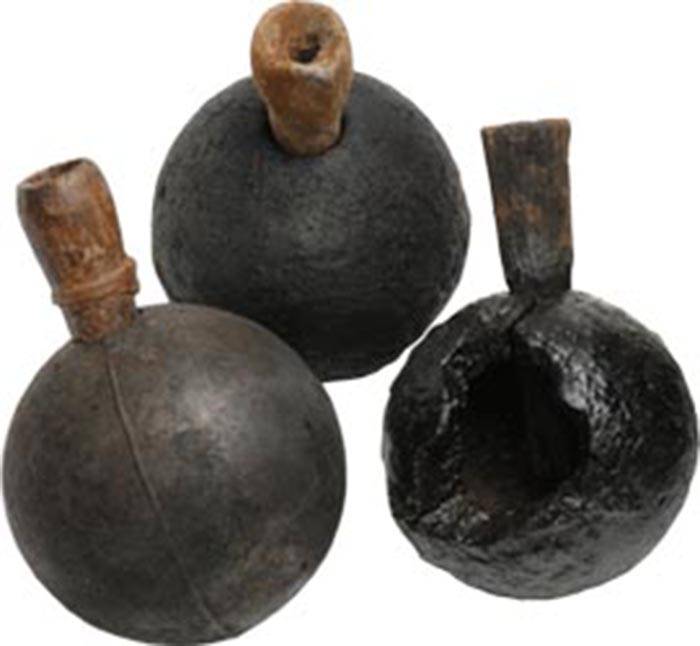
In the middle of the XVII century, grenades are equipped with a prototype of the inertial ignition. During the civil war in England (1642-1652), Cromwell's soldiers began to tie a bullet to the wick inside the shell, which, by hitting the ground, continued inertia and pulled the wick inside. They also proposed a primitive stabilizer to ensure the flight of a grenade wick back.
The beginning of the intensive use of grenades in field battles dates back to the 17th century. In 1667, in the English forces, soldiers were allocated (4 man per company) specifically for throwing projectiles. These fighters are called "grenadiers." They could only be soldiers with excellent physical shape and training. After all, the higher the soldier and the stronger, the farther he can throw a grenade. Following the example of the British, this kind of weapon was introduced into the armies of almost all states. However, the development of linear tactics gradually negated the advantage of using grenades, and by the middle of the XVIII century they were removed from the equipment of field units, the grenadiers became only elite troops of infantrymen. Grenades remained only in service with the garrison troops.
War of empires
The twentieth century hand grenade met with little used, old and forgotten weapons. In fact, it was the same black powder ammunition, which used the grenadiers of the XVII century. The only improvement made in the design of grenades for almost 300 years - the emergence of grater fuse.
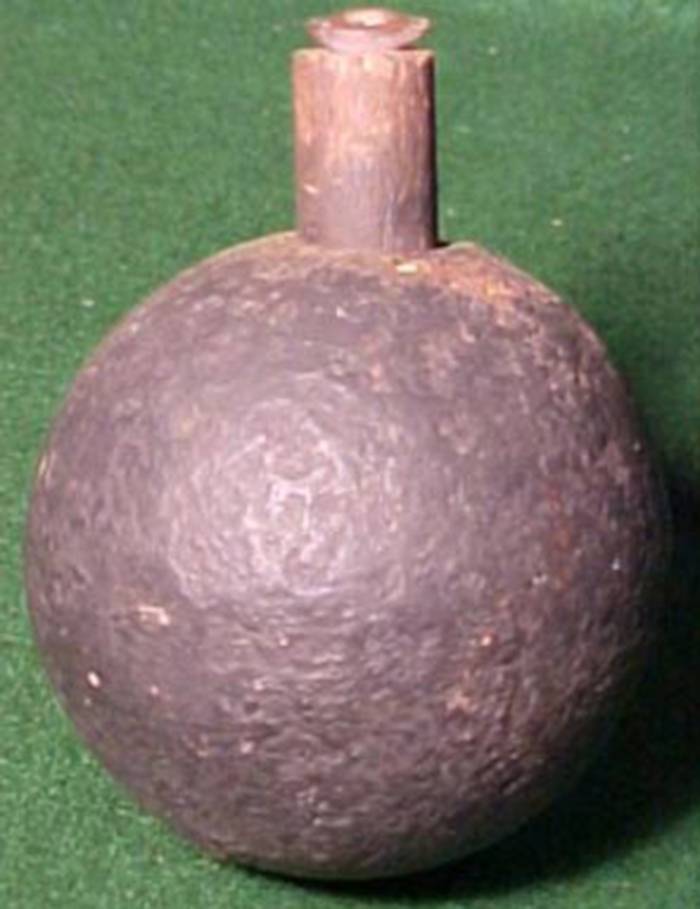
French ball grenade model 1882 of the year, used during the First World War. The grenade body is a simple, spherical shape (the diameter of the ball was 81 mm), made by casting from cast iron, with a hole under the igniter. The ground of the grenade could be both a shock and a simple wick, ignited by a match. But the most typical of a spherical grenade was a "bracelet" (grating) fuse.
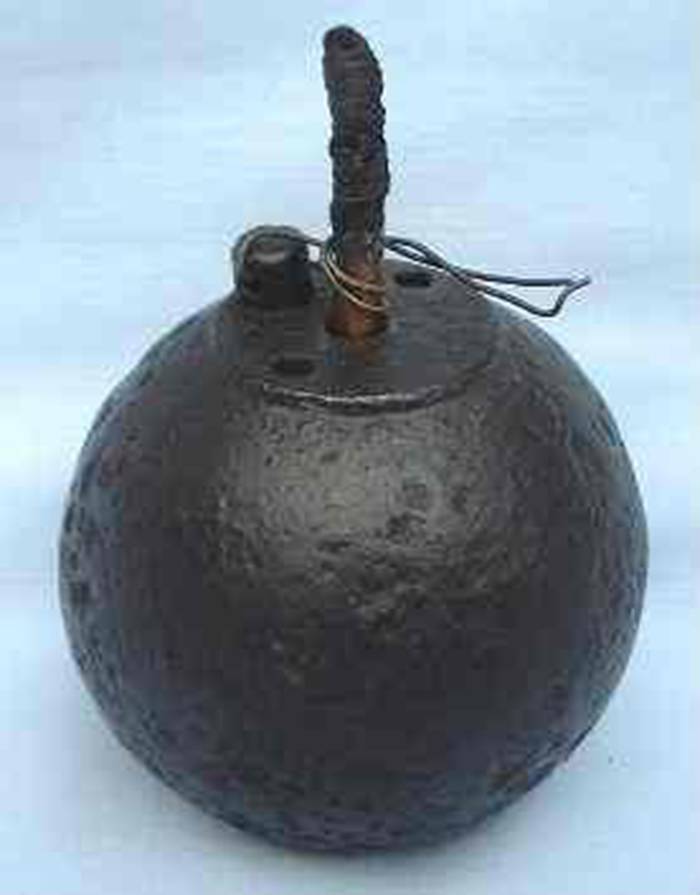
English "ball" grenade №15 sample 1915 year. The cast-iron case with a diameter of 3 inch, with internal notches for fragmentation was filled with black powder or ammonal. Fuse grenades №15 was a typical grating fuse, which developed the designer Brock. The fuse was very sensitive to moisture and often refused, therefore it was often replaced with a piece of fuck string.
In Russia, in 1896, the Artillery Committee ordered to completely dismantle hand grenades "... in view of the emergence of more sophisticated means of defeating the enemy, strengthening the defense of fortresses in the moats and the insecurity of hand grenades for the defenders themselves ...".
And after eight years, the Russo-Japanese war began. It was the first battle in the history of wars, in which met mass armies equipped with rapid-fire artillery, shop rifles and machine guns. The presence of new weapons and especially an increase in the range of fire weapons increased the capabilities of the troops and necessitated the use of new methods of action on the battlefield. Field shelters securely concealed opponents from each other, making firearms virtually useless. This forced both parties to the conflict to remember the forgotten form of infantry weapons. And given the lack of grenades in service, improvisation began.
For the first time Japanese use of grenades in the Russian-Japanese war recorded 12 in May 1904 of Qingzhou. The Japanese grenades consisted of liner trimming, bamboo tubes filled with explosive charge, standard explosive charges wrapped in cloth, in the ignition sockets of which incendiary tubes were inserted.
Following the Japanese, Russian troops began to use grenades. The first mention of their use dates back to August 1904.
The grenades in the besieged city were occupied by the headquarters captain of the mine company Melik-Parsadanov and the lieutenant of the Kvantunskoy sapper company Debigory-Mokrievich. In the maritime department, this work was entrusted to 2 rank captain Gerasimov and lieutenant Podgursky. In the defense of Port Arthur, 67 000 hand grenades were produced and used.
Russian grenades consisted of cuttings of lead pipes, sleeves into which 2-3 pyroxylin drafts were inserted. The ends of the case were closed with wooden lids with a hole for the pilot tube. Such grenades were supplied with a burning tube designed for 5-6 seconds of burning. Due to the high hygroscopicity of pyroxylin, the grenades equipped with them had to be used for a certain time after production. If dry pyroxylin containing 1-3% moisture exploded from a primer containing 2 g of rattling mercury, then pyroxylin containing 5-8% moisture required an additional dry pyroxylin detonator.
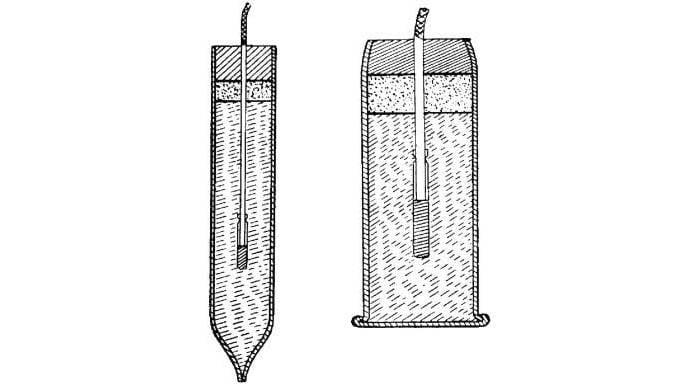
Grenades made in Port Arthur from scrap materials.
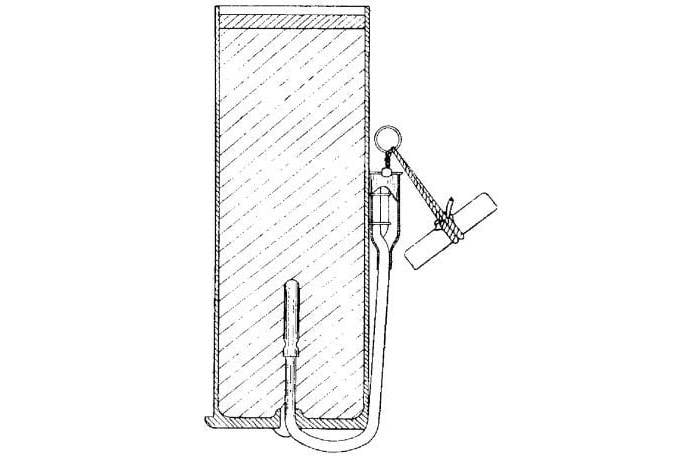
The illustration shows a grenade fitted with a pilot igniter. It was made from a 37-mm or 47-mm artillery shell. To the body of the grenade the case from the rifle cartridge, in which the grater igniter was located, was soldered. In dulce cartridge
the sleeve was inserted igniter cord and crimping Dultsev there fastened. Lace graters out through the hole in the bottom of the sleeve. The tertiary device itself consisted of two split goose feathers, entering cuts one into the other. The contacting surfaces of the feathers were covered with igniter composition. For convenience, a ring or a stick was tied to a cord.
To ignite the igniter cord, such a grenade needed to be pulled over the ring of the floater igniter. Friction between goose feathers during mutual displacement caused ignition of the trowel, and the ray of fire set fire to the igniter cord.
In 1904, for the first time in the Russian army, a shock grenade was introduced. The captain of the East Siberian mine company Lishin became the creator of the grenade.

Staff captain grenade Lishin of the early type.
Lessons of war
Intelligence of the whole world was interested in the development of events and the course of military operations in Manchuria. Britain sent the most observers to the Far East - it was tormented by the tragic experience of the war with the Boers. The Russian army received three British observers; from the Japanese side, 13 British officers observed the fighting. Together with the British, military attaches from Germany, France, Sweden and other countries watched the development of events. Even Argentina sent captain of the second rank José Moneta to Port Arthur.
The analysis of the combat operations showed that it is necessary to make substantial changes to the technical equipment, organization of the combat training of troops and their equipment. The war demanded the mass production of all types of weapons and equipment. Immeasurably increased the role of the rear. Uninterrupted power supply of troops with ammunition and food began to play a decisive role in achieving success on the battlefield.
With the advent of more advanced weapons, positional forms of struggle were born in the field. Machine guns and magazine rifles finally forced the troops to abandon the dense battle formations, chains became more rare. The machine gun and powerful fortifications sharply increased the possibility of defense, forced the attackers to combine fire and movement, use the terrain more carefully, dig in, reconnoiter, conduct attack fire training, widely use patrols and coverage, fight at night, better organize the interaction of troops on the field fight Artillery began to practice firing from closed positions. The war demanded an increase in the caliber of the guns and the wide use of howitzers.
The Russian-Japanese war made a much stronger impression on the German observers than on the French, the British and the military of other countries. The reason for this was not so much the best susceptibility of the Germans to new ideas, as the tendency of the German army to view the fighting from a slightly different angle. After signing the Anglo-French Agreement (Entente cordiale) in 1904, Kaiser Wilhelm asked Alfred von Schlieffen to develop a plan that would allow Germany to wage war on two fronts at the same time, and in December 1905, von Schlieffen set to work on his famous plan. An example of the use of grenades and trench mortars during the siege of Port Arthur showed the Germans that such weapons could also be effectively used in the German army if they were faced with similar tasks during the invasion of the territory of neighboring countries.
Already by 1913, the German military industry launched the mass production of Kugelhandgranate 13 grenades. However, to say that it was a revolutionary model, it is impossible. The traditional inertia of the thinking of military strategists of that time, which led to the fact that grenades continued to be considered only as a means of siege war, had an effect. The grenades of the 1913 model of the year were of little use as infantry weapons, primarily because of their spherical shape, which made their carrying less convenient for the soldier.
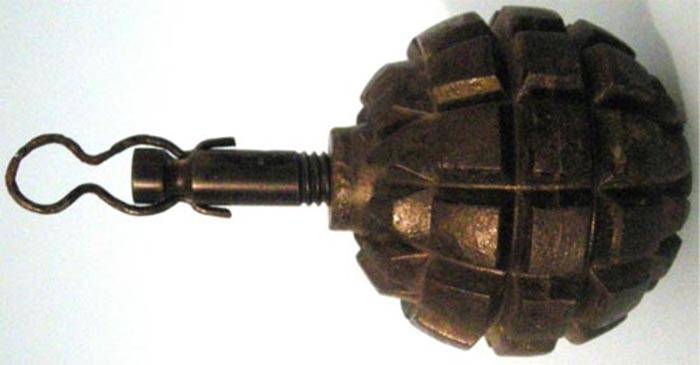
Kugelhandgranate 13 Model Aa
The grenade body consisted of a reworked, but almost unchanged as a whole idea of three hundred years ago - a cast iron ball with a diameter of 80 mm with a ribbed notch of a symmetrical shape and a point under the fuse. The grenade charge was a composite explosive based on black powder, that is, it had a low high-explosive effect, although because of the shape and material of the grenade body, it produced rather heavy fragments.
The ground of the grenade was quite compact and not bad for its time. It was a tube protruding from the body of a grenade on the 40 mm with a grating and distance composition inside. A safety ring was attached to the tube, and on top there was a wire eyelet that triggered the fuse. The deceleration time was supposedly about 5-6 seconds. An absolute positive was the absence of any detonator from the grenade, since its powder was ignited by force of the flame from the remote composition of the fuse itself. This increased the safety of handling the grenade and helped reduce the number of accidents. In addition, the charge, which had a low blisteringness, crushed the body into relatively large fragments, giving less "dust", harmless to the enemy, than grenades in melinite or TNT equipment.
Russia also took into account the experience of war. In 1909-1910, the captain of artillery Rdultovsky developed two samples of grenades with a remote igniter - small (two-pound) "for hunting teams" and large (three-pound) "for serf war". The small grenade, as described by Rdultovsky, had a wooden handle, the body in the form of a rectangular box made of zinc sheet, was filled with a quarter pound of melinite. Plates with cross-shaped notches were placed between the prismatic explosive charge and the walls of the case, and in the corners were ready triangular fragments (according to 0,4 g weight). On trials, the fragments "punched an inch board in 1-3 saggers from the explosion site," the throw distance reached the 40-50 steps.
Grenades were then considered an engineering tool and belonged to the jurisdiction of the Main Engineering Directorate (SMI). 22 September 1911 of the Engineering Committee of the SMI examined hand grenades of several systems - Captain Rdultovsky, Lieutenant Timinsky, Lieutenant Colonel Gruzevich-Nechay. The remark about the Timinsky grenade was typical: "It may be recommended in the event that it is necessary to make grenades in the troops," was the case with these munitions. But the greatest interest was caused by the Rdultovsky sample, although he demanded factory manufacturing. After completion, the Rdultovsky grenade was adopted under the designation "grenade sample 1912." (WP-12).
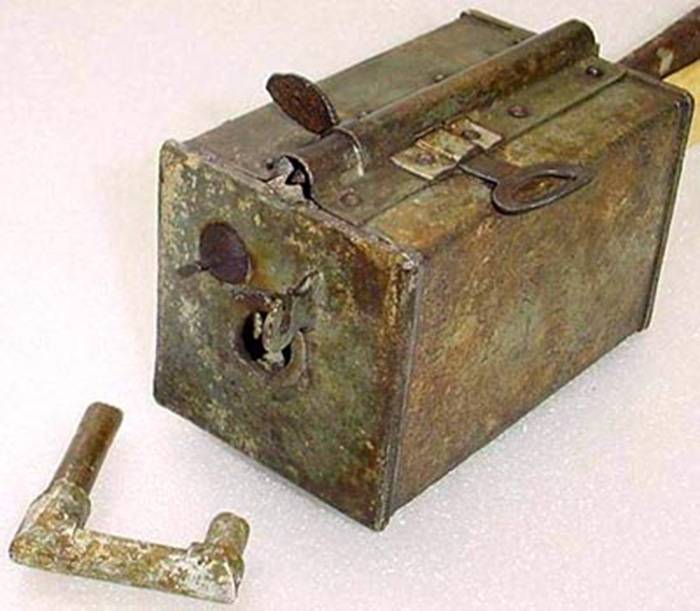
Grenade arr. 1912 (WG-12).
Just before the start of the First World War, Rdultovsky perfected the design of his grenade arr. 1912 g., And the armament of the Russian army received a grenade arr. 1914 (WG-14).
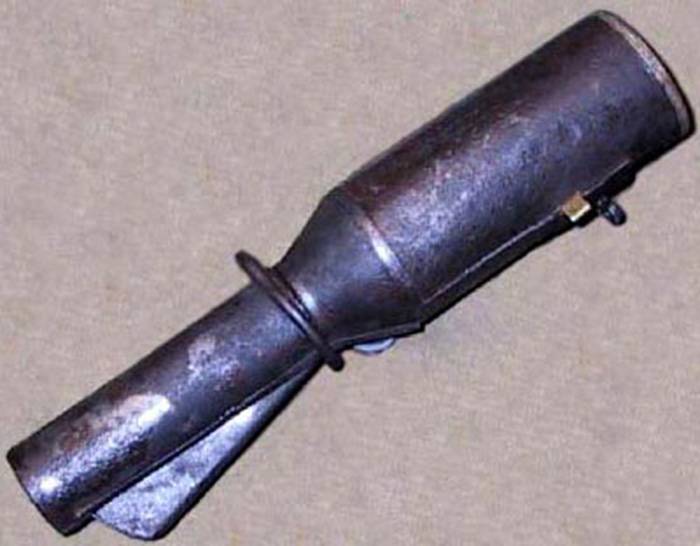
Grenade arr. 1914 (WG-14)
According to the design of a hand grenade arr. 1914 was not fundamentally different from the 1912 grenade of the sample. But there were still changes in the design.
The 1912 grenade did not have an additional detonator. In the garnet of sample 1914, an additional detonator made of pressed tetryl was used to equip it with TNT or melinite, but an additional detonator was not used when equipping with ammonal. Equipping grenades with different types of explosives led to a variation in their weight characteristics: a grenade equipped with TNT weighed 720 gr., Melinite - 716-717 gr.
The grenade was stored without a fuse and with a deflated drummer. Before throwing a fighter had to put a grenade on the fuse and charge it. The first meant: remove the ring, pull off the drummer, drown the lever in the handle (the hook of the lever captured the head of the drummer), put a safety check across the trigger window and put the ring on the handle and lever again. The second is to move the funnel lid and insert the fuse with a long shoulder into the funnel, the short one into the chute and fix the fuse with the lid.
For a throw, the grenade was clamped in the hand, the ring was moved forward, and the safety check was moved with the thumb of the free hand. In this case, the lever squeezed the spring and pulled the hook backwards with the hook. The coil spring shrank between the clutch and the trigger. When throwing the lever was wrung out, the mainspring pushed the drummer, and he pinched the primer-igniter. The fire through the stop threads was transmitted to the retarding composition, and then to the detonator cap, which undermined the explosive charge. Here, perhaps, all the modern at that time samples of hand grenades that were in the arsenals of the military when the Great War broke out.
First World War
28 July 1914 began the First World War, one of the largest armed conflicts in the history of mankind, as a result of which four empires ceased to exist. When, after an extremely dynamic campaign, the front lines froze in a positional war and the opponents sat in their deep trenches practically at a stone's throw distance, the history of the Russo-Japanese war repeated again, but with one exception - Germany. The Kugelhandgranate spherical grenade was the very first, which was mass-produced in sufficiently large quantities and delivered to the troops. The rest had to improvise again. The troops began to help themselves and began to produce various homemade grenades. With the use of empty cans, wooden boxes, cardboard boxes, scraps of pipes and the like, often with winding wire or stuffing with nails, more or less effective explosive devices were produced. Also, the most diverse were the charges, as well as detonators - simple fuse cords, grating fuses and so on. The use of such erzatsev was often associated with risk for the throwers themselves. It required a certain dexterity and composure, therefore it was limited to sapper units and small, specially trained infantry units.
In relation to the effort expended on production, the effectiveness of homemade grenades left much to be desired. Therefore, at an ever-increasing pace, more effective and convenient grenades were developed, suitable, in addition, for mass-scale mass production.
Consider all the samples that created the designers during the First World War in the amount of one article is not possible. Only in the German army during this period was used 23 type of various hand grenades. Therefore, we will dwell on two constructions that ultimately led to the appearance of the F-1 grenade.
Taking into account the experience of fighting 1914, the British designer William Mills has developed a very successful, one might say, a classic example of a grenade. Grenade Mills was adopted by the army of Great Britain in 1915 year under the name "Mills Bomb No. 5".
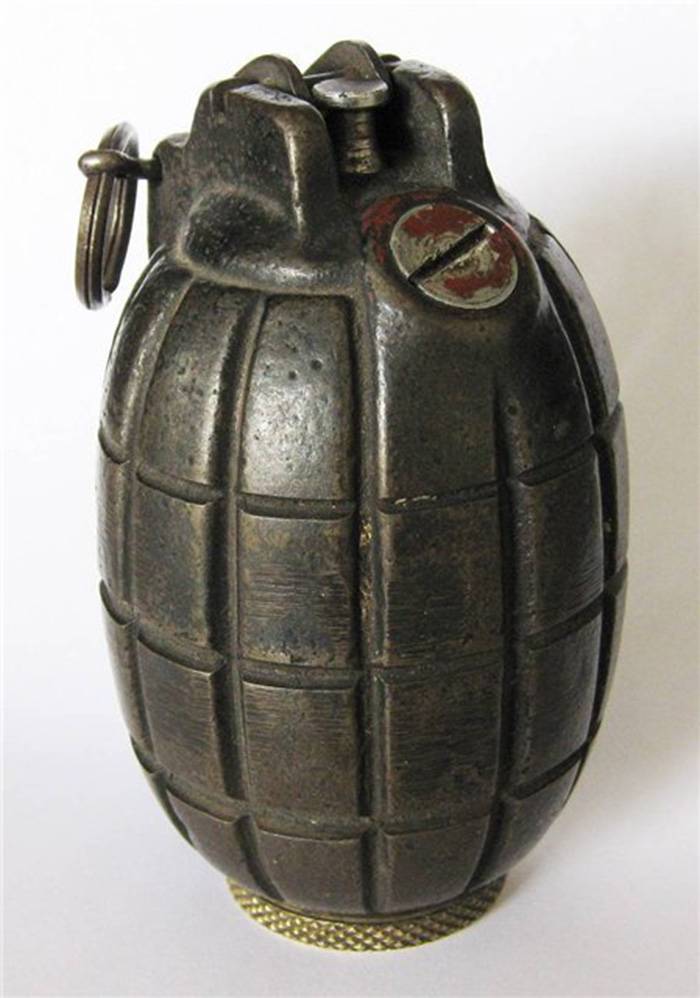
Mills Bomb No. 5
Grenade Mills belongs to the defensive anti-personnel fragmentation hand grenades of a defensive type.
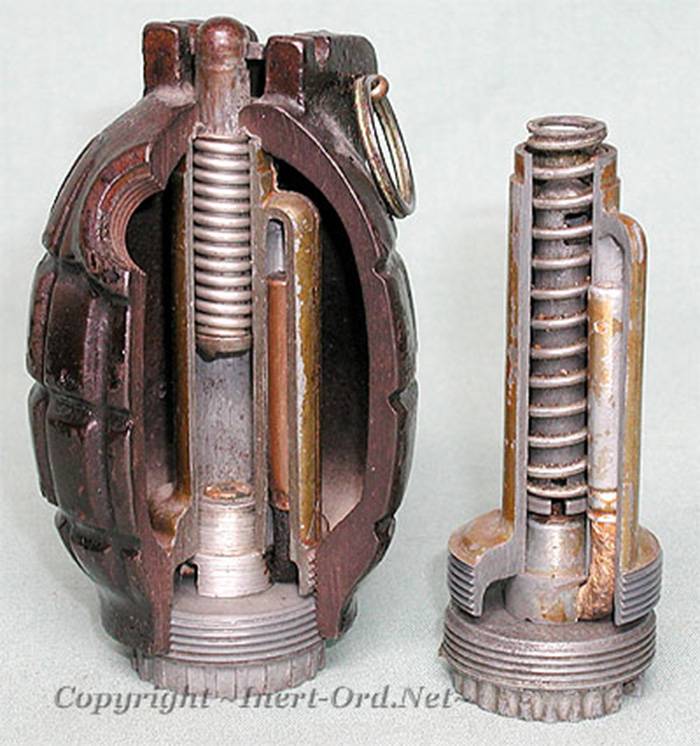
Grenade number 5 consists of a body, an explosive charge, a shock-protection mechanism, a fuse. The body of the grenade is designed to accommodate the explosive charge and the formation of fragments during the explosion. The body is made of cast iron, has transverse and longitudinal notches on the outside. In the lower part of the body there is a hole into which the central tube is screwed. In the central channel of the tube is placed a drummer with a mainspring and primer igniter fuse. The fuse itself is a segment of an igniter cord, at one end of which a primer-igniter is fixed, and on the other end a detonator capsule. It is inserted into the side channel of the tube. The housing bore is closed with a screw plug. To use the Mills Bomb №5 grenade, you must unscrew the washer on the underside of the grenade, insert the detonator cap into it and re-wrap the washer in place. To use a grenade, you must take a grenade in your right hand, pressing the lever against the body of the grenade; use your left hand to bring together the antennae of the safety checks (cotter pin) and, pulling the ring, pull the cotter pin out of the hole in the lever. After that, swinging, throw a grenade into the target and take cover.
The British managed to create a truly outstanding weapon. Grenade Mills embodied the tactical demands of the "trench warfare" imposed on this type of weapon. Small, comfortable, this grenade was conveniently thrown from any position, despite its size, it gave quite a lot of heavy fragments, creating a sufficient area of damage. But the biggest advantage of the grenade was its fuse. It consisted in the simplicity of its design, compactness (there were no protruding parts), and that by pulling out the check ring, the fighter could safely hold the grenade in his hand while waiting for the most favorable moment for the throw, as long as the lever held up by the arm , the moderator does not ignite. German, Austro-Hungarian and some French samples of grenades did not have this truly necessary feature. The Russian Rdultovsky grenade that had such a feature was very difficult to use, its preparation for the throw required more than a dozen operations.
The French, who suffered no less than the British from German grenades in 1914, also decided to create a grenade with balanced characteristics. Correctly taking into account the shortcomings of German grenades, such as a large diameter, inconvenient body for covering, like a grenade of the 1913 sample of the year, an unreliable detonator and a weak fragmentation effect, the French developed a revolutionary for their time grenade design known as F1.
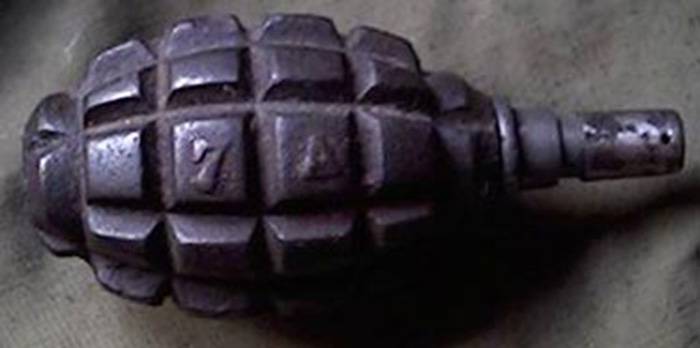
F1 with shock ignition ignition
Initially, the F1 was produced with ignition ignition ignition, but soon it was equipped with an automatic lever ignition, the design of which with minor modifications is still used today in many of the NATO Army fuses. The grenade was a cast-ribbed, ribbed, egg-shaped body of steel cast iron, with a hole for the fuse, which was more convenient for a throw than a round or disc-shaped body of German grenades. The charge consisted of 64 grams of explosive (TNT, schneiderite or less powerful substitutes), and the grenade mass was 690 grams.
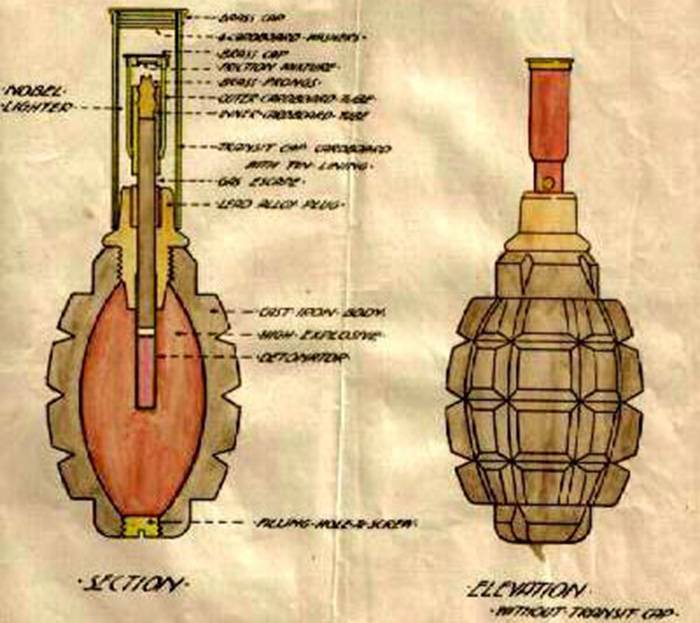
Initially, the fuse was a structure with a percussion primer-igniter and a moderator, the burn-out primer-detonator, which caused a grenade to explode. It was set in action by striking a cap with a fuse against a solid object (wood, stone, butt, etc.). The cap was made of steel or brass, had on the inside of the striker, smashed the cap, the type of rifle, set fire to the moderator. For safety, the fuses of the F1 grenades were supplied with a wire check, which prevented the drummer from touching the primer. Before throwing this fuse was removed. Such a simple design was good for mass production, but the use of a grenade outside the trench, when it was not possible to find the same solid object, clearly hampered the use of a grenade. Nevertheless, compactness, simplicity and high efficiency ensured huge popularity for grenades.
At the time of the explosion, the body of the grenade is broken into more than 200 large heavy fragments, the initial velocity of expansion of which is about 730 m / s. In this case, 38% of the mass of the body goes to the formation of carcass fragments, the rest is simply sprayed. The reduced area of fragmentation of fragments is 75 – 82 м2.
The F1 hand grenade was quite technologically advanced, did not require scarce raw materials, carried a moderate explosive charge and at the same time had a lot of power and produced a large amount of slaughter fragments at that time. Trying to solve the problem of properly crushing the hull during an explosion, the designers used a deep notch on the hull. However, combat experience has shown that with modern blasting explosives, the hull of such a shape during an explosion is crushed unpredictably, with the majority of the fragments having a small mass and light-slaughter within the 20-25 radius, while the heavy fragments of the bottom, the top of the grenade and the fuse have a high energy due to its mass and dangerous to 200 m. Therefore, all the allegations that the notch has as its goal the formation of fragments in the shape of protruding ribs is at least incorrect. The same should be said about the obviously inflated defeat distance, since the range of continuous destruction by shrapnel does not exceed 10-15 meters, and the effective range, that is, where at least half of the targets will be struck - 25-30 meters. The 200 number of meters is not a range of destruction, but a range of safe removal for its parts. Therefore, it was necessary to throw a grenade out of cover, which was quite convenient in the case of a positional war.
The F1 imperfections were hit very soon. The imperfect fuse was the Achilles' heel of the whole structure, and in comparison with the Mills grenade it was clearly outdated. The very design of the grenade, its efficiency and production features did not cause complaints, on the contrary, they were outstanding.
At the same time, in 1915, in a short time, the French designers invented the automatic spring-loaded fuse, like Mills, however, in many ways it was superior.
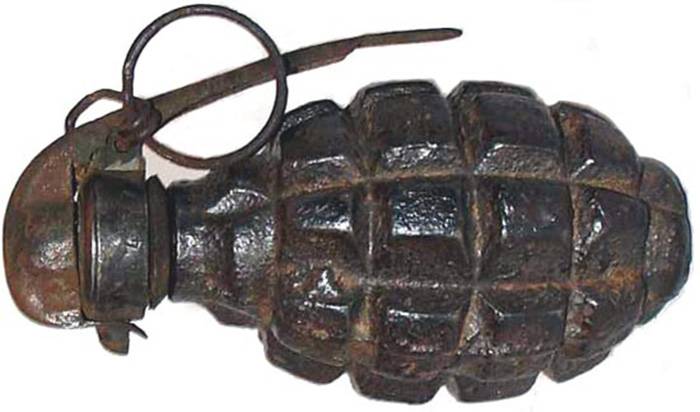
F1 with automatic lever ignition
Now the grenade, ready for the throw, could be held in the hands indefinitely - until the moment more favorable for the throw came, which is especially valuable in a fleeting fight.
The new automatic fuse was combined with a moderator and a detonator. The fuse screwed into the grenade from above, while Mills had the impactor mechanism integral from the body, and the detonator was inserted from the bottom, which was very impractical — it was impossible to visually determine whether the grenade was charged. This problem was not with the new F1 - the presence of a fuse was easily determined and meant the readiness of the grenade for use. The remaining parameters, including the charge and rate of combustion of the moderator, remain the same as in the F1 grenade with ignition ignition ignition. In this form, the French F1 hand grenade, like the Mills grenade, was a truly revolutionary technical solution. Its shape and weight and size indicators were so successful that they served as role models and were embodied in many modern models of grenades.
During the First World War, grenades F 1 in large quantities were supplied to the Russian army. As in the west, hostilities soon revealed the urgent need for the Russian army to use hand grenades. We did this at the Main Military Technical Directorate (GVTU), the successor of the SMI. Despite the new proposals, the main grenades become arr. 1912 and 1914. Their production is being established in state technical artillery establishments - but, alas, too slowly. From the beginning of the war through 1 in January 1915, the entire 395 930 grenades were sent to the troops, mainly arr. 1912. Since the spring of 1915, grenades have gradually come under the jurisdiction of the Main Artillery Directorate (GAU) and are included in the number of "fixed artillery supply means".
To 1 in May 1915. 454 800 grenades arr. 1912 and 155 720 - arr. 1914 Meanwhile, in July of the same year, the Head of the State Agrarian University estimates only the monthly need for hand grenades in 1 800 000 pieces, and the Chief of Staff of the Supreme Commander reports to the Head of the Military Ministry the opinion of the Supreme on the need to prepare “revolvers, daggers and, especially, grenades” with a link to experience of the french army. Portable weapons and hand grenades really become the main armament of infantry in trench warfare (at the same time, by the way, there were also means of protection against hand grenades in the form of nets over trenches).
In August, 1915 was required to bring supplies of grenades to 3,5 million units per month. The range of use of grenades is growing - August 25 The commander-in-chief of the armies of the North-Western Front is asking for supplying the guerrilla hundreds with “hand bombs” for operations in the enemy's rear. The Okhta and Samara Explosives Plants have by this time passed an 577 290 grenade arr. 1912 and 780 336 grenades arr. 1914, i.e. their production for the whole year of the war amounted to only 2 307 626 pieces. To solve the problem, placing orders for grenades abroad begins. Among other samples it is delivered to Russia and F1. And along with the others, after the end of the world and civil war, inherited by the Red Army.
From F1 to F-1
In 1922, the Red Army was armed with seventeen types of hand grenades. Moreover, no fragmentation defensive grenades of their own production.
As a temporary measure, a grenade of the Mills system was adopted, the stocks of which in warehouses were of the order of 200 000 pieces. In the extreme case, the issuance of French grenades F1 to the troops was allowed. French grenades were delivered to Russia with Swiss percussion fuses. Their cardboard cases did not provide tightness and the detonation composition was dampened, which led to massive grenade failures, and even worse, to the backache, which was fraught with an explosion in the hands. But given that the stock of these grenades was 1 000 000 pieces, it was decided to equip them with a more advanced fuse. Such a fuse was created by F. Koveshnikov in 1927 year. The tests made it possible to eliminate the identified shortcomings, and in 1928, the F1 grenade with the new fuse was adopted by the Red Army called the F-1 hand grenade with the F.V. fuse. Koveshnikov.
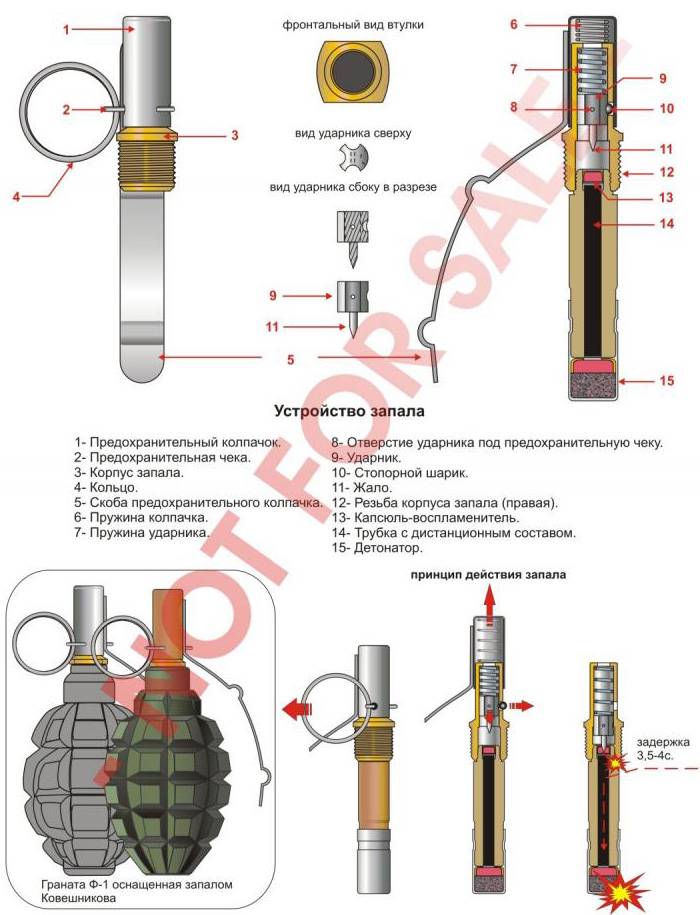
In 1939, the military engineer F.I. The temple churches of the People's Commissariat of Defense, modeled on the French F-1 manual fragmentation grenade, developed a sample of the Russian F-1 defensive grenade, which was soon mastered in mass production. Grenade F-1, like the French sample F1, is designed to defeat enemy forces in defensive operations. With her combat use, the throwing fighter needed to hide in a trench or other defenses.
In 1941, the designers E.M. Vincene and A.A. The poor have developed and put into service instead of the Koveshnikov fuse, a new, more secure and simpler in design, fuse to the F-1 hand grenade. In 1942, the new fuse became one for the F-1 and RG-42 hand grenades, it was called the UZRG - “the unified fuse to the hand grenades”. The fuse of a UZRGM type grenade was intended for the explosion of a bursting charge of a grenade. The principle of the mechanism was remote.
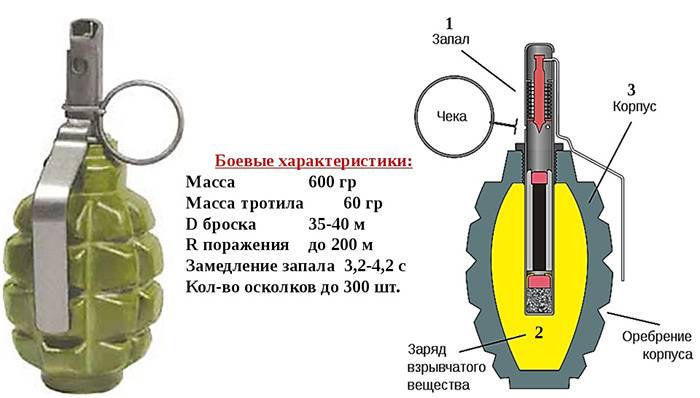
The manufacture of F-1 grenades during the war years was carried out at plant No. 254 (from 1942), 230 (Tizpribor), 53, in the workshops of Povenetsky ship-repair plant, mechanical plant and railway junction in Kandalaksha, central repair shops of the Forty NKVD, artel "Primus" (Leningrad), many other non-core other domestic enterprises.
At the beginning of the Great Patriotic War, grenades were loaded instead of trotyl, even with black powder. A pomegranate with such a filling is quite effective, although less reliable. After World War II, upgraded, more reliable fuses for UZRGM and UZRGM-1 began to be used on F-2 grenades.
At present, the F-1 grenade is in service in all armies of the countries of the former USSR, and it has also become widespread in Africa and Latin America. There are also Bulgarian, Chinese and Iranian copies. Copies of the F-1 can be considered the Polish F-1, the Taiwanese defensive grenade, the Chilean Mc2.
It would seem that the F-1 grenade, as a representative of the classic type of hand grenades with a solid cast iron body of virtually natural crushing and a simple, reliable distance igniter, cannot compete with modern grenades of the same purpose — both for optimal fragmentation and for ignition. . All these tasks are solved in a different way at the modern technical, scientific and production levels. So, in the Russian Army a RGO (hand defensive grenade) grenade was created, largely unified with the RGN grenade (offensive hand grenade). The unified fuse of these grenades has a more complex device: its design combines remote and impact mechanisms. Grenades have a much greater effectiveness of fragmentation.
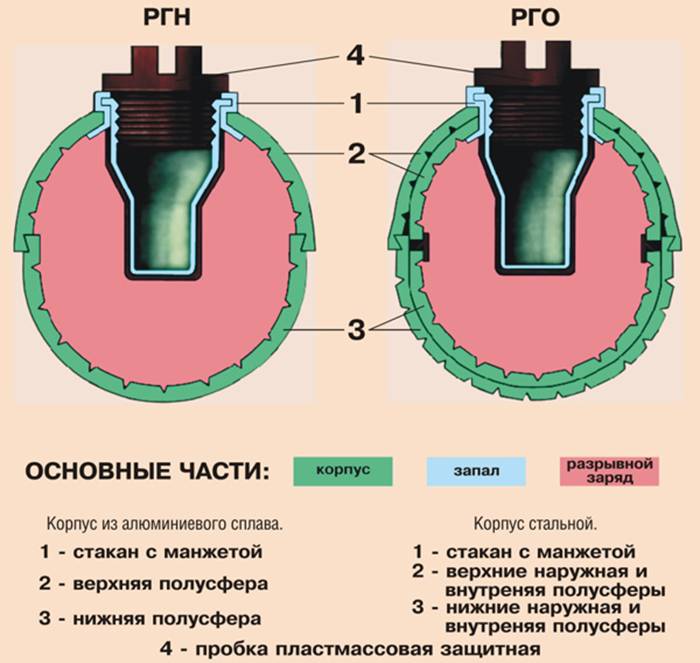
However, the F-1 grenade has not been removed from service and will probably remain in service for a long time. There is a simple explanation for this: simplicity, low cost and reliability, as well as time verification are the most valuable qualities for weapons. And in a combat situation, these qualities do not always have the opportunity to oppose the technical perfection, which requires large production and economic costs. In confirmation of this, we can say that the English grenade Mills mentioned in the article is still formally in service with the armies of the NATO countries, therefore, in the 2015, the grenade also celebrated its 100 anniversary.
And why "lemon"? There is no consensus about the origin of the nickname “lemon”, which is called the grenade F-1. Some associate this with the similarity of the grenade with lemon, however, there are opinions stating that this is a distortion from the name “Lemon”, who was the designer of the English grenades, which is not quite true, because the French have invented F1.
Sources:
Brief description of the device and the use of F-1 brand hand grenades with a F.V. Koveshnikov. Artillery Office of the Red Army. M. 1937
A. A. Blagonravov, M. V. Gurevich. Ammunition of small arms. Cartridges, hand and rifle grenades. Their device. L .: Publication of the military-technical academy of the Red Army named after Comrade. Dzerzhinsky, 1932
IN AND. Murokhovsky, S.L. Fedorov. Infantry weapons. Publishing campaign "Arsenal Press". Moscow. 1992
The magazine "Weapon" №№6-99g., 8-99g.
Site weaponland.ru
Information